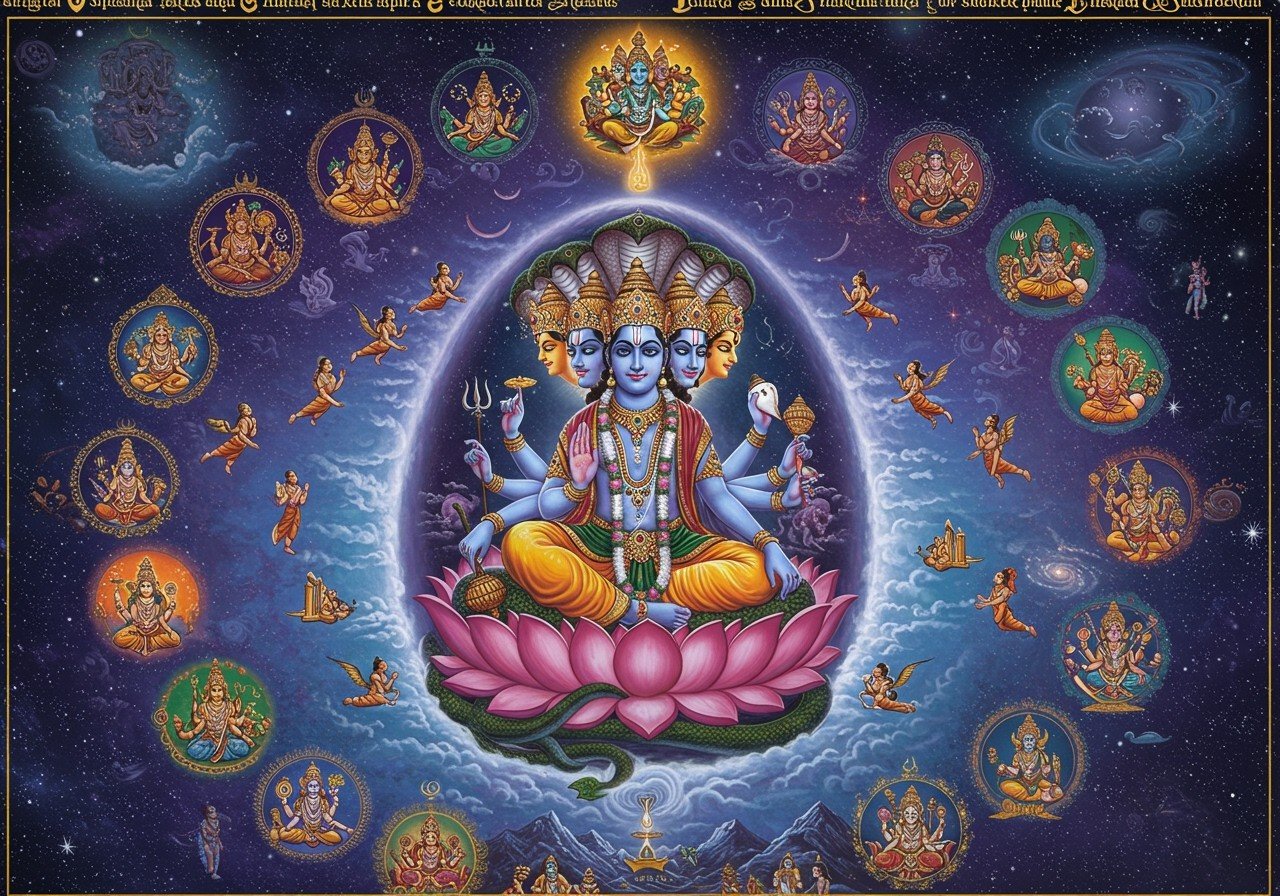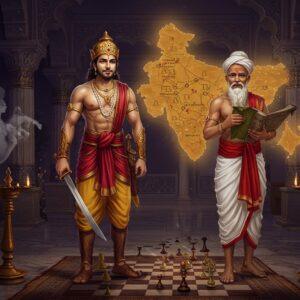
Hindu cosmology is a vast and intricate system of beliefs that provides a framework for understanding the universe and our place within it. It’s a rich tapestry woven with philosophical concepts, mythological narratives, and spiritual practices that have shaped the lives of millions for millennia. This exploration delves into the core principles of Hindu cosmology, its key deities, and their enduring cultural significance. Understanding concepts like ‘cosmology,’ ‘lokas,’ and ‘deities’ is crucial as they are deeply intertwined with daily rituals and spiritual practices.
Hindu Cosmology: A Framework for Understanding
Hindu cosmology presents a universe in perpetual motion, a cyclical dance of creation, preservation, and destruction. This cosmic cycle is encapsulated in the concept of the Brahmanda, the cosmic egg, symbolizing the universe’s cyclical nature. Time itself is cyclical, flowing through vast epochs known as Yugas. Currently, we reside in the Kali Yuga, a period characterized by spiritual darkness. At the heart of Hindu cosmology lies Brahman, the ultimate reality, the source from which all existence springs. Brahman is the unchanging truth that underpins all phenomena. The cyclical nature of the universe is embodied by the Trimurti – Brahma, the creator; Vishnu, the preserver; and Shiva, the destroyer. These deities represent the dynamic forces that shape the cosmos.
Hindu cosmology goes beyond a single universe, envisioning countless universes, each with its own Trimurti and cyclical journey. This multiplicity speaks to the profound interconnectedness of all things. The individual soul, or atman, is seen as a spark of the divine, inextricably linked to the universal soul, Brahman. The world we perceive, however, is often veiled by Maya, the cosmic illusion, which can obscure our understanding of true reality. Within this vast cosmic expanse exist three principal worlds: Bhurloka (the earth), Swargaloka (the heavens), and Patala (the netherworlds). These realms represent different levels of existence within the broader framework of the Triloka, encompassing the physical, mental, and spiritual planes.
The Origins and Dynamics of the Universe
Ancient Hindu texts like the Rigveda and the Puranas describe the universe’s emergence from primordial waters, set in motion by the divine sound Om. This sacred sound continues to hold immense significance in Hindu rituals, symbolizing the power of creation. The universe is also conceptualized through the Purusha Sukta hymn, where the cosmic being, Purusha, sacrifices himself to form the universe. This concept reveals the interconnectedness between the divine and the cosmos.
Prakriti (nature) and Purusha (consciousness) are fundamental dualities in Hindu cosmology. These two forces interact to drive the universe’s dynamic processes. The cosmic dance unfolds through the cycles of Srishti (creation), Sthiti (preservation), and Samhara (destruction), overseen by the Trimurti. The lotus flower, a symbol of purity and beauty, represents the unfolding of creation from the primordial waters. Its emergence from murky depths symbolizes the potential for spiritual growth and enlightenment.
Lokas: The Realms of Existence
Hindu cosmology elaborates on different realms of existence known as Lokas, each playing a distinct role in the cosmic order. Bhurloka, the earthly realm, is our home, where we experience the cycles of life, death, and rebirth. It serves as the stage for our spiritual growth and evolution. Swargaloka, the heavenly realms, are the abode of deities and virtuous souls, inspiring aspirations for spiritual attainment reflected in rituals and practices. Patala, the netherworlds, often associated with demons and serpents, represent the darker aspects of existence. Brahmaloka, the highest realm, represents the ultimate goal of spiritual liberation (Moksha), where the individual soul merges with Brahman. The Chaturdasha Lokas, fourteen realms described in Hindu scriptures, hold cultural significance, influencing art, literature, and temple architecture. They represent a hierarchical view of the cosmos and offer insights into human experience and spiritual evolution.
Key Deities: Guardians of the Cosmos
The Hindu pantheon is rich with deities, each embodying different aspects of the divine. The Trimurti – Brahma, Vishnu, and Shiva – play central roles as the creator, preserver, and destroyer, respectively. Their consorts – Saraswati (wisdom), Lakshmi (prosperity), and Parvati (strength) – further enrich the symbolic tapestry of Hindu cosmology. Ganesha, the remover of obstacles, and Hanuman, the embodiment of devotion and strength, are revered deities who play crucial roles in Hindu mythology and spiritual practice. Vishnu’s ten incarnations, the Dasavatara, are significant figures who appear throughout history to restore cosmic balance and uphold dharma. Regional and family deities further enhance the rich tapestry of Hindu beliefs, reflecting the diversity of cultural and spiritual practices.
Lord Brahma: The Architect of Creation
Lord Brahma, the creator god, holds a significant position within the Trimurti. Depicted with four faces and four arms, Brahma symbolizes his omniscience and mastery of the Vedas. He is the architect of the universe, bringing forth all life forms and establishing cosmic order. While Brahma temples are relatively rare, his presence is invoked in daily Hindu rituals and mantras. The Brahma Muhurta, the period before dawn, is considered highly auspicious for spiritual practices, connecting with Brahma’s creative energy.
At Poojn.in (https://www.poojn.in), you can find a selection of sacred items to enhance your connection with Lord Brahma:
- Exquisite Brass Brahma statues (https://www.poojn.in/product/9375/radha-krishna-10-astadhatu-brass-radha-krishna-murti-pure-pital-brass-radha-krishna-to-worship) perfect for your home temple, crafted with intricate detail to honor the creator god. These statues serve as a focal point for meditation and prayer.
- Sacred thread (Janeu) (https://www.poojn.in/product/11870/mangalam-camphor-butter-paper-400g-approx-200-pieces) blessed for creation ceremonies, symbolizing spiritual connection and purity. These threads are essential for various Hindu rituals and ceremonies.
Embracing the Hindu Universe: A Path to Understanding
The Hindu universe offers a profound and intricate worldview, connecting the past, present, and future through its rich cosmology, philosophical concepts, and divine figures. By exploring these teachings, we gain a deeper understanding of ourselves and our place within the cosmos. From the cyclical nature of time to the concept of Lokas, Hindu cosmology provides a framework for navigating life’s journey. The deities, each embodying unique qualities and powers, offer guidance and inspiration on our spiritual path. By embracing these teachings, we can find greater harmony and meaning in our lives.
Frequently Asked Questions about the Hindu Universe
What is Hindu cosmology?
Hindu cosmology is a complex system of beliefs and philosophies that describe the origin, structure, and cycles of the universe. It provides a framework for understanding the nature of reality, time, and the divine.
What are the key elements of Hindu cosmology?
Key elements include the concepts of Brahman (ultimate reality), Trimurti (the divine trinity of Brahma, Vishnu, and Shiva), Lokas (realms of existence), Yugas (cycles of time), and the cyclical nature of creation and destruction.
Who are the principal deities in Hindu cosmology?
The principal deities are the Trimurti: Brahma (the creator), Vishnu (the preserver), and Shiva (the destroyer). Other important deities include Devi (the divine feminine), Ganesha (remover of obstacles), and Hanuman (symbol of devotion and strength).
What is the significance of Lokas in Hindu cosmology?
Lokas represent different planes or realms of existence within the universe. They range from the earthly realm (Bhurloka) to heavenly realms (Swargaloka) and netherworlds (Patala), providing a framework for understanding the various levels of existence.


